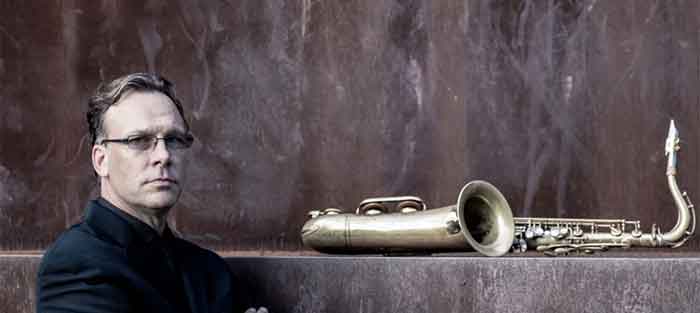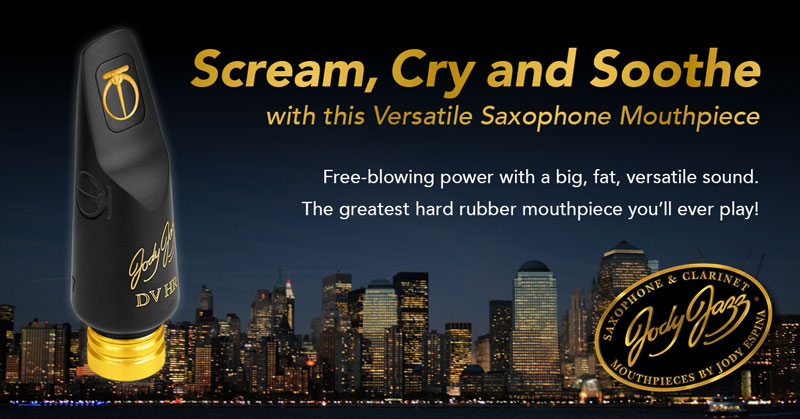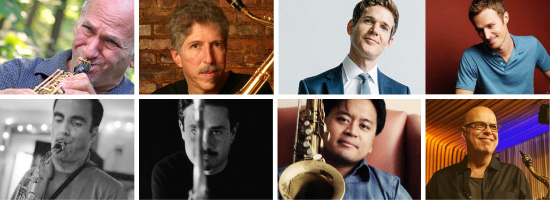Tim Armacost’s Twisty Path to Pro Saxophonist, Practice Routine, and More
 Introduction
Introduction
I remember seeing Tim play at Jamey Aebersold’s jazz camp when I was in high school, and have been following his playing ever since. Luckily, I was recently able to see Tim play at Jazz Chez Hanny in San Francisco and Tim was nice enough to meet with me to further share his story and what he is currently working on. For those of you who are not familiar with Tim Armacost, check out a short bio below to get yourself up to speed.
Biography
- Tim Armacost is a Grammy nominated saxophonist who has lived and played across three continents establishing himself as one of the most distinct saxophone voices in NYC.
- Tim’s extended residencies in India, Holland, Japan, and now New York have informed his wide-ranging musical explorations.
- Tim has worked as a sideman as well as a leader with such jazz icons as Jimmy Cobb, Kenny Barron, Al Foster, Billy Hart, Tom Harrell, Victor Lewis, Jeff “Tain” Watts, Ray Drummond, Peter Erskine, Roy Hargrove, Don Friedman, and Randy Brecker.
- Besides being an accomplished saxophonist, Tim composes for his group ranging from trio to big bands. Tim is a recipient of the prestigious Doris Duke/CMA “New Works” award.
- Armacost has recorded 16 albums as a leader, 60 as a sideman, and 100 original songs and arrangements to date.
- While Tim is not playing or composing, he can be found as a music faculty member at Queens College and has been a guest conductor and soloist at the Juilliard School, Temple University, Indiana University Bloomington, UNC, NC State, etc. In addition, Tim was a regular faculty member at Jamey Aebersold’s Summer Jazz Workshops.
- Currently, Tim co-leads the New York Standards Quartet, the Brooklyn Big Band and In Trio, and is currently working on two projects: a chord-less quintet featuring Tom Harrell, Gary Smulyan, John Patitucci, and Al Foster, and a tenor and vibes frontline quintet with Joe Locke, Jim Ridl, Kenny Davis, and Rudy Royston.
Interview
ZS: Who introduced you to the saxophone? What made you choose the saxophone over other instruments?
TA: I was inspired to start playing by Benny Goodman. My parents took me to a live concert at Wolf Trap when I was seven or eight years old. It was one of those indoor-outdoor concert halls. I remember lying back on the grass listening to Benny Goodman and thinking, “yeah, I got to play that instrument.” So, I started playing clarinet the next year while in Japan. I played clarinet for about six years and I was always the first clarinet player in the section.
When I was going into ninth grade, there were two girls in my class and they both went to clarinet camp over the summer. When they came back from camp, they were both playing great and beat me out for the first chair. At the same time, my little brother started playing alto saxophone and he was incredibly talented. He is now a businessman, but he can really play and kind of sounds like Sonny Stitt. When my little brother started playing alto, a sibling rivalry kicked in and I decided it was time for me to switch to the tenor saxophone. I chose the tenor because it was bigger than the alto but when looking back, I am definitely a tenor player and not an alto player.
From a musical point of view, the tenor tends to sit right in the middle of the band due to its frequency range. With the tenor, you can be in the middle of the band and be influencing the swing and the groove where the alto with its higher frequency, tends to fly on top of the band. Time is one of the most important things to me because time generates the deepest feeling so it made sense for me to choose tenor because it fit my personality.
I moved from Japan to Bethesda Maryland when I was in junior high school and my older brother was one of the star trumpet soloist in the high school band. He was my second real inspiration after Benny Goodman. Hearing my brother taking some solos in the big band was very inspiring. When I chose tenor, I actually went to Chuck Levin’s music store and I just tried a couple horns because I didn’t know much about gear. I tried Coufs and Selmers and the Couf was just the one that felt good in my hands. What I liked about the Couf horn was it had rolled tone holes, and I appreciated that level of craftsmanship.
After high school, I got accepted to Pomona College which is a very difficult school to get into now and I lucked out. I think they appreciated a more well-rounded person rather than an academic superstar. In addition to music, I was the captain of my high school basketball team but at the college level it became pretty clear that there wasn’t a real future for me in basketball, but music felt like it had real legs.
Ponoma was a real stroke of luck because Bobby Bradford taught Jazz History and Ensembles (who was associated with Ornette Coleman) and Charlie Shoemake had a studio and taught pretty much everyone who wanted to learn how to improvise around Los Angeles. When I was graduating college, I remember Charlie telling me “you’re done here, you don’t need to study with me anymore, you need to go out and play.” At that point, I was thinking of either going to graduate school to get a degree in Japanese Studies, becoming a Zen Buddhist priest, or trying to become a jazz musician. I saved money for half a year and then took off and went to Europe and long story short landed in Amsterdam. A couple of doors opened in Amsterdam which made it possible for me to stay there. The plan was for me to try out being a professional musician and see if I liked it and could make a living. If it didn’t work out, I would head back home and go to graduate school but not in music but study and become an academic.
After about a year in Amsterdam, it became very clear that if I stayed in Amsterdam I was going to be a musician and never look back. It worked out and I had a great life in Amsterdam where I had a lot of students and was playing five to six nights a week. I don’t know if I would have gotten that level of playing experience in the States.
Although the daily work experience in Europe was incredible, this work was not going to take me to the next level like what was possible in New York. Now, I am not saying I was good enough yet, but the difference in New York is the possibility to get a big sideman gig with someone like Art Blakey or Miles. At the end of my time in Holland, I was getting to be known as a teacher because I had a couple of students who had come out and done really well. Two other conservatories offered me jobs which was the next turning point. I could have taken these teaching jobs, taught five days a week and had a life of middle class success but that was not what I was looking for. I wanted to be pushed artistically.
This was the moment when Joe Lovano emerged. Joe was presenting something that was so artistically attractive to me because he could function in a pure straight ahead bebop context to somewhere in the middle between Coltrane and Ornette and finally could play comfortably totally free which was exactly what I was looking for. In Holland, the scenes were separated between free musicians and straight ahead musicians and they didn’t seem to really like each other. I liked to play in both scenes. Joe Lovano showed me that you could live on the whole spectrum and it was clear to me it was time to head to NYC.
ZS: As you have progressed on the saxophone and continue to develop your own sound and technique, who did you try to emulate the most and what was your process?
TA: I admired Hank Mobley’s harmonic elegance – the way he mastered harmony and put together beautiful lines. When I went to Charlie Shoemake he asked me what I was looking for and I told him I wanted to play long flowing lines, and Shoemake introduced me to Hank Mobley. The first solo I worked on was Sonny Rollins and the second was Hank Mobley.
I am still trying to make beautiful lines like Hank Mobley’s, and work on it everyday. I listen to Sonny Rollins for melodic development. Trying to play an idea and then iterate the idea and see if I can follow that path so the improvisation unfolds in a way that has some logic but is not predetermined. That’s something Sonny Rollins does so well.
I checked out Coltrane for harmonic innovations but the deepest thing I got from studying Coltrane’s music was that Trane passed through bebop, hard bop, Miles Davis (transcending the traditional rhythm section concept), and moving onto the influence of Ornette Coleman and Free Jazz. I feel like Coltrane arrived at the ability to play exactly what was in his mind and delivered it immediately without inhibition. I don’t know if that is what happened to him but that is how I hear it. Coltrane constructed the music around the idea of giving himself the opportunity to just flow everything from his mind out of his saxophone.
I listened to Dexter Gordon for time. Dexter’s laid back time influences me every single day. I checked out Harold Land for the connection to the blues even while playing bebop.
Finally, I have been checking out for quite some time Wayne and Ornette Coleman compositionally and Tom Harrell and Freddie Hubbard for their phrasing.
ZS: Who were your saxophone influences growing up and have they stayed the same or changed over time?
TA: I probably spend more time these days listening to piano players like Herbie Hancock and am inspired by McCoy Tyner’s playing. At my age now, it’s more about writing music and creating vehicles that are interesting to explore. I am not working on jazz vocabulary as much as I used to.
I didn’t mention Brecker but Michael Brecker was a big influence after studying the traditional players. After seeing Joe Henderson live, he influenced the way I played time. Joe Henderson’s approach to time is the second most influential on me after Dexter Gordon.
Nowadays, the guys who I really like are the one’s whose mind I find interesting. The first one that comes to mind is Craig Handy. When I listen to Craig, it’s not about the notes and harmony so much but it’s about how he moves from one idea to the next. Joel Frahm is another one who when I listen to I often think, “yeah, that is just the way I would have tried to do that.”
Jorge Sylvester is an alto player not enough people know about and he lives between Eric Dolphy and Kenny Garrett and is a very interesting alto player. I do like a couple of other alto players like Andrew Gould, Caleb Curtis, and Jaleel Shaw.
ZS: When it comes to teaching and practicing, what is your process? In what ways have you approached practicing that you have found is different from the mainstream?
TA: The way I would describe it is from the inside-out and the outside-in. What inside-out means is training myself with the goal in mind of what I described Coltrane doing. The goal being to be able to play whatever is in my mind directly through the saxophone.
I start my practice day by just free associating melodically. The idea being to tune in to my imagination, trying to imagine music and play it directly. I do this very slowly, playing a fifth at the bottom of the piano to set a tonal center.
My first activity of my practice day is to free associate melodically. One of the things that Charlie Shoemaker taught me was that if you play by ear, your ear, no matter how good it is, will only deliver what it knows. So you have to teach it to hear new things.
The second half of the process is outside-in meaning training my inner voice to hear those new things. I will spend some time finding a melody on the piano and teaching myself to play that, or going to a Hank Mobley solo that I haven’t learned before and taking new phrase, learning to hear it, singing it, and then trying to play that phrase that I just taught myself without interference. I think transcription is incredibly valuable, but if you are learning with your eyes and your fingers, that is not going to take you deep.
You need to learn by training your inner voice to hear it and then to match with the saxophone what you’re singing with your inner voice. To me that is closing the gap between what I can imagine and what I can play everyday. It’s not easy to do and it takes some patience and perseverance but it is a good process. I know a good book that may discusses this in more detail [ed: Tim laughs, as he is referring to his own book, The Jazz Saxophone Book]
ZS: As you have played throughout the states, Europe and Asia, what differences have you seen in terms of the audience engagement and interest in Jazz?
TA: As a working jazz musician, I definitely feel more appreciated in Europe and Japan. It’s kind of similar to maybe what it would feel to be a professional soccer player in the United States. In the US, you have baseball, basketball, football, hockey, tennis, etc. – that there are so many sports that we value before we get to soccer. It’s not that Americans are not good at soccer or can’t play the game but it’s just so far down the cultural totem poll that it doesn’t get the level of attention that it gets with the whole rest of the world. We just had the Grammys and there are 150 awards being given now and the jazz categories start in the 80’s which means there are 70 genre’s of music that are considered a higher priority than jazz, and that is economic and partly cultural.
That being said, because jazz comes from American culture and grows out of this culture, when you get in front of an American audience who knows the music and loves it, that’s the deepest experience as a performer.
When I play at Smalls for a really enthusiastic audience, it’s thrilling. There is a jazz series out in the Midwest called “We Always Swing,” run by Jon Poses and he has created a great audience because he knows the music. Jon brings high quality musicians in and the audience has learned to trust him and they know what they are hearing now; so to play for that audience is also thrilling.
ZS: What are your thoughts on the importance of the equipment and how did you land on the H Couf Superba 1? Do you find yourself changing much or sticking with the same gear? Is there any gear not available for saxophonists that you wish existed today?
TA: I took saxophone lessons from saxophonist Doc Ross, who taught at the University of Maryland. He took me from the student model H. Couf to the professional model. Doc told me especially when it came to mouthpieces to go try them all. He gave me a bunch of brand names but didn’t tell me Coltrane or Michael Brecker played this mouthpiece or that one, he advised me to pick the one that feels good in my mouth.
It was great to get advice where the core of the message was basically – pick the mouthpiece that your body and soul resonates with, don’t pick something that will make you sound like somebody else, pick that mouthpiece that makes you feel good.
I’ve been playing on the same mouthpiece, saxophone, and reeds for the past 44 years but the one thing I change is I get a new ligature every ten years or so. The one piece of gear I wish I could get was an Aulochrome, which is a double soprano made by Francois Louis.
Equipment
Tenor:
- Saxophone: H Couf Superba 1
- Ligature: Ishimori Wood Stone Ligature
- Reed: D’Addario Royal 3.5
- Mouthpiece: Berg Larsen Stainless Steel mouthpiece 105/2 (Vintage)
- Case: BAM La Defense Cabine for Tenor
- Neckstrap: Ray Hyman strap
Soprano:
- Saxophone: Yamaha 62 RS purple logo curved neck soprano
- Ligature: Francois Louis
- Reed: D’Addario Royal 2
- Mouthpiece: Bari 68
- Case: Reunion Blues Leather gig bag
- Neckstrap: none
Bass Clarinet:
- Royal Polaris
- Ligature: Rovner Platinum
- Reed: D’Addario Select Jazz for Tenor 3M
- Mouthpiece: Vandoren B50
Clarinet:
- Buffet Crampon
- Ligature: D’Addario H
- Reed: D’Addario Royal 3
- Barrel: Backun Fatboy
Flute
- Haynes – Silver, Open Hole
Alto Flute
- Trevor James – Masters Series, Silver
Connect:





